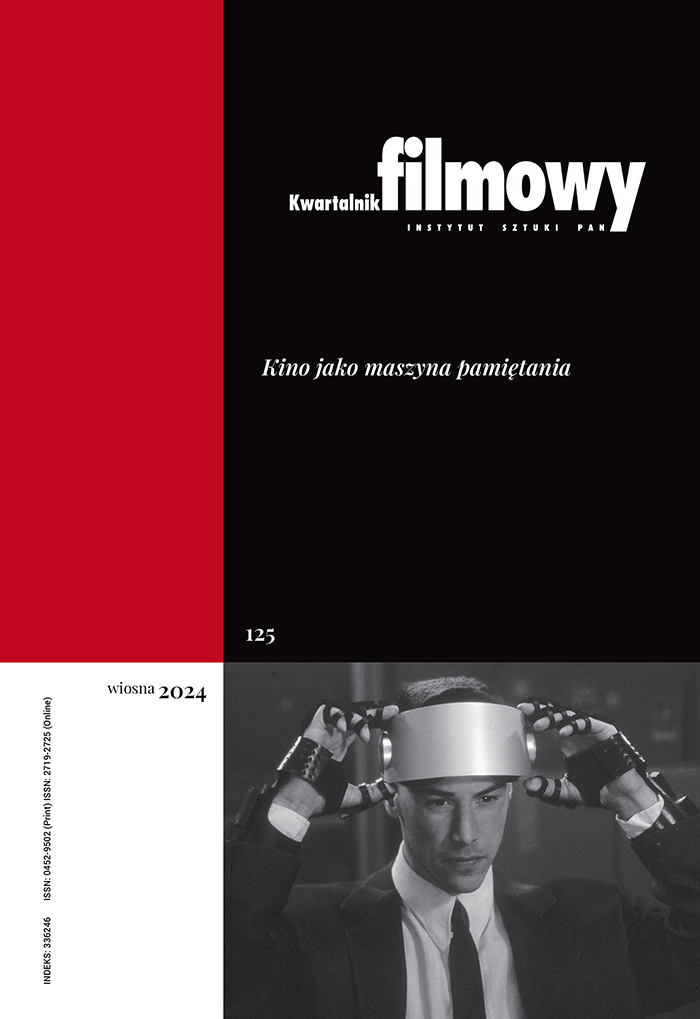Frank Capra’s “It’s a Wonderful Life” – the Paradoxes of Interpretations
Abstract
It’s a Wonderful Life (1946) is perhaps the most famous and frequently cited film in the area of American pop culture. Described as populist and sentimental, the work of Frank Capra is of great interest to researchers both from the broadly defined cultural studies, as well as historians and political scientists. The aim of the article is to point out some, often divergent, interpretations of the film. Their presentation points to the nuances and shades of meaning of It’s a Wonderful Life, which often remain unseen due to the affective dimension of the film.
Keywords:
Frank Capra, American cinema, sentimentalismReferences
Belton, Johan. American Cinema/American Culture, 2nd edition. New York City: McGraw-Hill, 2005.
Google Scholar
Capra, Frank. The Name above the Title: An Autobiography. Boston: Da Capo Press, 1997.
Google Scholar
Carreras Kuntz, María Elena de las. “The Catholic Vision in Hollywood: Ford, Capra, Borzage and Hitchcock.” Film History 14 (2002): 121--35.
DOI: https://doi.org/10.2979/FIL.2002.14.2.121
Google Scholar
Costello, Matthew. “The Pilgrimage and Progress of George Bailey: Puritanism, It’s a Wonderful Life, and the Language of Community in America.” American Studies 40 (1999): 31–52.
Google Scholar
Goodman, Ellen. “As ‘A Wonderful Life’ Hits 50.” The Washington Post, December 21, 1996.
Google Scholar
Kuhn, Annette. “Columbia Pictures.” In The Cinema Book, 3rd edition, edited by Pam Cook, 30—34. London: BFI, Palgrave Macmillan, 2009.
Google Scholar
Maltby, Richard. Hollywood Cinema, 3rd edition. Malden (MA, USA), Oxford (UK), Carlton (Victoria, Australia): Blackwell Publishing, 2003.
Google Scholar
McBride, Joseph. Frank Capra: The Catastrophe of Success. Jackson: University Press of Mississippi, 2011.
DOI: https://doi.org/10.14325/mississippi/9781604738384.001.0001
Google Scholar
Noakes, John A., “Bankers and Common Men in Bedford Falls: How The FBI Determined That It's A Wonderful Life Was a Subversive Movie.” Film History [Australia] 10 (3) (1998): 311--19.
Google Scholar
Ociepa, Krzysztof. “Ameryka New Dealu w stylu capresque: Pan z milionami, Mr Smith jedzie do Waszyngtonu i Obywatel John Doe Franka Capry.” In Kino amerykańskie: Dzieła, edited by Elżbieta Durys and Konrad Klejsa, 9‒45. Kraków: Rabid, 2006.
Google Scholar
Ostrowska-Chmura, Elżbieta. “Frank Capra – marzenia i koszmary.” In Mistrzowie kina amerykańskiego: Klasycy, edited by Łukasz A. Plesnar, Rafał Syska, 181‒207. Kraków: Rabid, 2006.
Google Scholar
Ray, Robert B. A Certain Tendency of the Hollywood Cinema, 1930‒1980, Princeton (New Jersey): Princeton University Press, 1985.
DOI: https://doi.org/10.1515/9780691216164
Google Scholar
Schatz, Thomas. Boom and Bust. American Cinema in the 1940s. Berkeley, Los Angeles, London: University of California Press, 1997.
Google Scholar
Schultz, Robert. “Celluloid History: Postwar Society in Postwar Popular Culture.” American Studies with American Studies International, 31 (1990): 41‒63.
Google Scholar
Silverma, Kaja. The Acoustic Mirror. The Female Voice in Psychoanalysis and Cinema. Bloomington and Indianapolis: Indiana University Press, 1992.
Google Scholar
Silverman, Kaja. “Male Subjectivity and the Celestial Suture “It’s a Wonderful Life”.” In Feminism and Film, edited by E. Ann Kaplan, 100‒118. New York: Oxford University Press, 2000.
Google Scholar
Silverman, Kaja. Male Subjectivity at the Margins. New York & London: Routledge, 1992.
Google Scholar
Wood, Robin. “Ideology, Genre, Auteur.” In Film Genre Reader III, edited by Barry Keith Grant, 60–74. Austin: University of Texas Press, 2003.
Google Scholar
Wróbel, Szymon. “Efekt interpelacji.” Teksty Drugie 3 (2012): 22‒33.
Google Scholar
Authors
Elżbieta Duryskwartalnik.filmowy@ispan.pl
University of Lodz Poland
Dr hab., adiunkt na Wydziale Studiów Międzynarodowych i Politologicznych Uniwersytetu Łódzkiego. Autorka artykułów publikowanych w czasopismach i antologiach. Współredaktorka książek poświęconych kinu amerykańskiemu oraz tematyce gender. Autorka dwóch monografii: Mieliśmy tu mały problem... O twórczości Johna Cassavetesa (2009) i Amerykańskie popularne kino policyjne w latach 1970-2000 (2013).
Statistics
Abstract views: 356PDF downloads: 248
License
Copyright (c) 2016 Elżbieta Durys

This work is licensed under a Creative Commons Attribution 4.0 International License.
The author grants the publisher a royalty-free non-exclusive licence (CC BY 4.0) to use the article in Kwartalnik Filmowy, retains full copyright, and agrees to identify the work as first having been published in Kwartalnik Filmowy should it be published or used again (download licence agreement). The journal is published under the CC BY 4.0 licence. By submitting an article, the author agrees to make it available under this licence.
In issues from 105-106 (2019) to 119 (2022) all articles were published under the CC BY-NC-ND 4.0 licence. During this period the authors granted a royalty-free non-exclusive licence (CC BY-ND 4.0) to use their article in „Kwartalnik Filmowy”, retained full copyright, and agreed to identify the work as first having been published in our journal should it be published or used again.
Most read articles by the same author(s)
- Elżbieta Durys, Screening Life: Within the Formula of Filmic Biography , Kwartalnik Filmowy: No. 114 (2021): Contamination, Dirt, Flaw
- Elżbieta Durys, On Three Tendencies of the Cinema of National Remembrance , Kwartalnik Filmowy: No. 125 (2024): Cinema as a Memory Machine
- Elżbieta Durys, Cinema Genres and Film Cycles , Kwartalnik Filmowy: No. 97-98 (2017): Wandering Motifs
- Elżbieta Durys, The Ritual Structuring of Experiences: “Husbands” by John Cassavetes , Kwartalnik Filmowy: No. 41-42 (2003): Myth and Film











